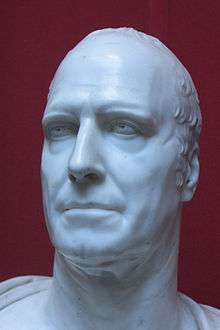Lawrence Macdonald

Lawrence Macdonald sometimes Laurence Macdonald (15 February 1799 -4 March 1878) was a Scottish sculptor, operational in the 19th century.
Life
He was born at Findo Gask in Perthshire, Scotland.
He was son of Alexander Macdonald, a poor violinist, and Margaret Morison, his wife. [1]
He was apprenticed as a stonemason with Thomas Gibson, who was then building the Murray Royal Asylum, just outside Perth, and about this time he carved the arms of Robert Graeme on the front of Garvock House. Coming to Edinburgh with an introduction to James Gillespie Graham the architect, who proved a helpful patron, he worked as an ornamental sculptor, and on 26 February 1822 entered the Trustees' Academy, Edinburgh, then on Picardy Place. [1]
Early in the winter of the same year he went to study in Rome, where he executed several busts, among others that of the John Murray, 4th Duke of Atholl ; and in 1823, along with Gibson, Severn, and other artists, founded the British Academy of Arts in Rome, of which he continued a trustee till his death. [1]
In about four years he returned to Edinburgh, and there produced busts of Professor John Wilson and George Combe, the phrenologist. In 1829, he sent his bust of John Marshall, M.P., to the Royal Academy, and he was a frequent contributor to the succeeding exhibitions. In the autumn of 1829, he exhibited in the Royal Institution, Edinburgh, his colossal group of ‘Ajax bearing the dead body of Patroclus and combating ‘an warrior’ and other works; and he was second to his friend Charles Maclaren, editor of the ‘Scotsman,‘ in his bloodless duel with Dr. James Browne, editor of the ‘Caledonian Mercury,’ fought near Edinburgh in November 1829, which arose partly out of an article in the ‘Mercury’ (6 November) on Macdonald’s works and the ‘Scotsman‘s’ criticisms upon them. In the same year he was elected a member of the Scottish Academy, where in 1832, he exhibited several busts, including those of J. Gibson Lochhart and the Earl Erroll; but be seldom contributed here, and resigned his membership in 1858. He appeared in the list of honorary members in 1867. [1] At this time he is shown as living at 10 Cumberland Street in Edinburgh's Second New Town.[2]
In 1832 he returned to Rome, where he occupied a leading position as a sculptor, chiefly producing portrait busts, aided by his elder brother, John, and his son, Alexander. His bust of Philip Henry, fifth Earl Stanhope, is now at Chevening, Kent, and a copy is in the National Portrait Gallery, London. [1]
He also executed busts of Walter Scott (1831), Fanny Kemble, Sir David Baird. and James Gillespie Graham. Among his ideal works are ‘A Girl and a Carrier Pigeon,’ 1835, and ‘Eurydice,’ 1849. His ‘Ulysses recognised by his dog,’ shown in the Paris Exhibition of 1855, was much admired, and became the property of Lord Kilmorey. [1]
He died in Rome.[1]
Several sculptors trained under him, including William Brodie.
Principal Works
Whilst Macdonald made statues of classical and mythological figures, all his portraiture was in the form of busts.
- James Gillespie Graham (1827)
- The Duke of Atholl, Blair Atholl, (1827)
- Robert Phillips, (1829)
- Earl of Errol (1832)
- Viscountess Canning, Highcliffe Castle (1838)
- Lord Alexander Russell, Woburn Abbey (1839)
- Lady Ebury, Apsley House (1839)
- Lord Charles Montagu, Kimbolton Castle (1840)
- Sir Henry Taylor, National Portrait Gallery, London (1843)
- Lord Compton, Castle Ashby (1843)
- The Duke of Cambridge, Windsor Castle (1846)
- The Hon Mrs Sidney Herbert, Wilton House (1848)
- Statue of Hyacinthus, Windsor Castle (1852)
- Duke of Northumberland (1853)
- Earl Stanhope, Chevening House, Kent (1854)
- Watts Russell, Ilam Church, Staffordshire (1863)
- Earl Stanhope, Chevening, Kent (n.d.)
- George Combe, Scottish National Portrait Gallery (n.d.)
References
- List of works selected from the Dictionary of British Sculptors, 1660-1851, by Rupert Gunnis
- Attribution
![]() This article incorporates text from a publication now in the public domain: Gray, John Miller (1893). "Macdonald, Lawrence". In Lee, Sidney. Dictionary of National Biography. 35. London: Smith, Elder & Co.
This article incorporates text from a publication now in the public domain: Gray, John Miller (1893). "Macdonald, Lawrence". In Lee, Sidney. Dictionary of National Biography. 35. London: Smith, Elder & Co.